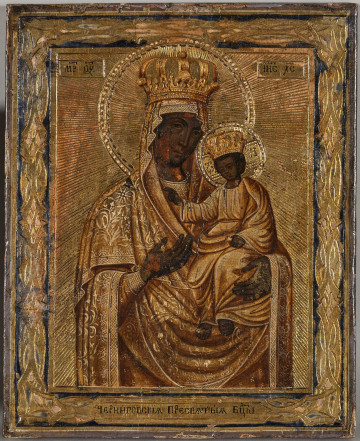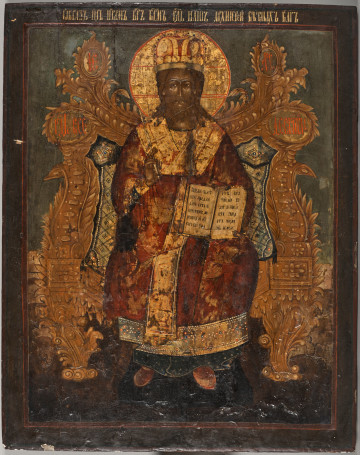
The Mother of God of Hodigitria
19th (?) century
Castle Museum in Łańcut
Part of the collection: Ikony
Crucifixion, silhouette icon Crosses are among the oldest and most used objects of Christian worship, accompanying people from birth to death. The cross was used to baptise, bless, people swore on the cross, travelled with the cross, it was used in healing, burials, passing from generation to generation. Crosses made of metal alloys were very popular (see S.12789MŁ – 12795MŁ; S.12869MŁ – 12875MŁ). On the cross, in addition to the image of the crucified Saviour, there sometimes are depictions that complement the content. According to the Gospel narrative, these include the figures accompanying the Crucifixion: The Blessed Virgin Mary and Martha (the Gospels mention several women) and the youngest disciple of Christ, John the Evangelist called the Theologian and the converted centurion Longinus. In the older tradition, their half-figures were placed at the ends of the central beam by the hands of Christ (see S.12789MŁ; S.12870MŁ) or standing in full figure were set beside the vertical beam of the cross in the base. In the perfected forms of the metal crosses of the Old Believers who did not accept the liturgical reform of Patriarch Nikon, in the middle of the 17th century the figures accompanying the Crucifixion began to be composed on plaques on both sides of the cross, as on the presented example. They were given the colloquial name “polotyentsa”, or towels, because the crosses, which were very much esteemed by the Old Believers, were decorated with colourfully embroidered white towels with loosely hanging sheets. The crosses cast in metal were often set in the grooves of wooden supports, sometimes called “kyots”, where together with other metal icons they formed a kind of iconostases, customarily called “stauroteks” (see S.12828MŁ). The crowning of the cross described, surrounded by eight-winged angel heads, testifies to its Guslicy origin or its imitation. In Guslicy, near Moscow, in the 19th century Old Believers produced on a large-scale metal crosses and icons decorated in this way. Teresa Bagińska-Żurawska https://orcid.org/0000-0002-9243-3967
Dimensions
height: 22.5 cm, width: 12.5 cm
Object type
Icons
Technique
cast, tin coating
Material
tin, brass
Origin / acquisition method
decyzja administracyjna
Creation time / dating
Creation / finding place
Owner
Castle Museum in Łańcut
Identification number
Location / status

19th (?) century
Castle Museum in Łańcut

1800 — 1850
Castle Museum in Łańcut

1800 — 1899
Castle Museum in Łańcut
DISCOVER this TOPIC
National Museum in Szczecin
DISCOVER this PATH
Educational path